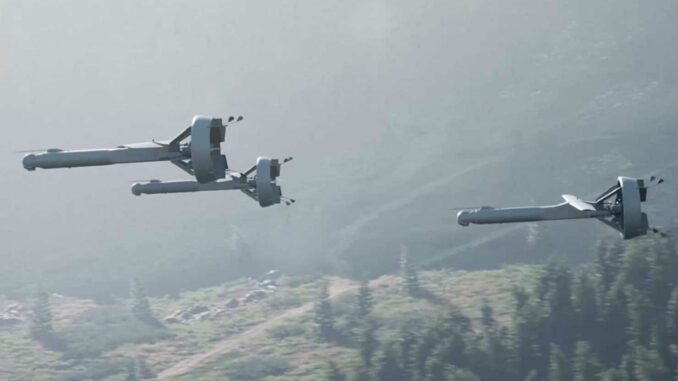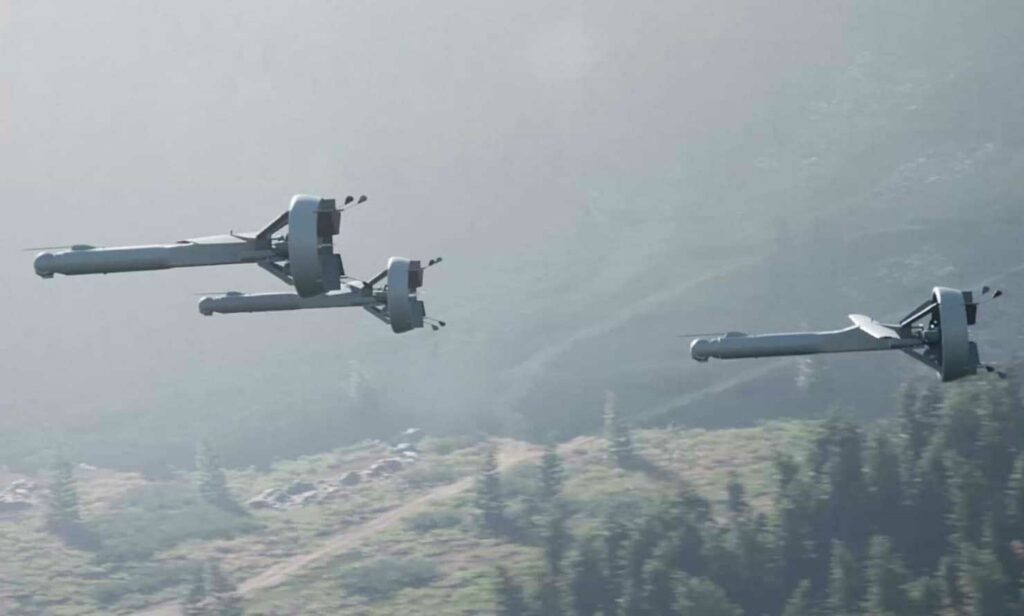
Shield AI’s Hivemind software redefines drone and aircraft autonomy: architecture, civil and military uses, positioning vis-à-vis the competition.
In summary
The Hivemind software, developed by the American company Shield AI, is a suite of autonomy software for drones, aircraft and unmanned vehicles, capable of executing complex missions in GPS- and communications-degraded environments. The system is designed around a modular architecture comprising three pillars (‘Edge’, ‘Design’ and ‘Commander’) enabling perception, cognition and multi-agent team action. Militarily, Hivemind enables, for example, squadrons of V-BAT family VTOL drones to fly in a coordinated manner without direct human intervention. In the civilian sector, potential applications include fire monitoring, autonomous logistics and infrastructure inspection. Faced with competitors such as Anduril Industries and other manufacturers of autonomous platforms, Shield AI stands out for its multi-platform portability, open software architecture and integration rate, which has been validated on more than a dozen different aircraft. However, the race remains open in terms of standards, certification and volume growth. With Hivemind, Shield AI is positioning itself as a key player in embedded autonomy at a time when intelligent drones are entering arsenals and industrial chains.
Hivemind software and its technology
Hivemind software is Shield AI’s flagship software product. It is an ecosystem of embedded artificial intelligence tools, combining perception, cognition and action for unmanned platforms. The architecture is based on three pillars:
- Hivemind Edge for embedded autonomy, dedicated to hostile environments without GPS or reliable communication.
- Hivemind Design for the development, testing and simulation of autonomous capabilities on platforms, including in the cloud or locally.
- Hivemind Commander for the human-machine interface, mission planning and human-on-the-loop control.
Architecture and operation
Hivemind’s logic is based on a modular and open approach: each mission can be built from re-composable blocks that combine sensor, navigation, tactical planning or autonomous action functions.
The platform is hardware-agnostic: it can be deployed on light drones, VTOL UAVs, aircraft, and even maritime or underwater systems.
Perception is based on on-board sensors (Lidar, cameras, IMU, radar) and AI processing to operate in environments now referred to as DDIL (Disconnected, Degraded, Intermittent, Low-bandwidth).
Cognition enables tactical decisions to be made, multiple agents to be coordinated, and the mission to be adapted in real time. The software operates without the need for a continuous ground-to-air link or GPS.
This results in automatic control of the platform (take-off, navigation, flight, mission, return) with minimal supervision.
Notable capabilities
Demonstrations include:
- Autonomous flight of an MQ-20 Avenger aircraft equipped with Hivemind, capable of switching from one software to another in flight, in a test configuration in February 2025.
- Mission of a trio of V-BAT drones in swarm mode for surveillance and reconnaissance in a complex environment, to be tested in late 2023.
- Claimed capability to cover an area of 30,000 square miles (~78,000 km²) and track up to 1,000 objects simultaneously in a swarm configuration.
Military and civil uses
Military application
Hivemind was designed to meet modern operational needs: suppression of air defences, reconnaissance in contested areas, autonomous drone squadrons, support for manned aircraft. For example:
- Shield AI’s V-BAT Teams system uses Hivemind for command and control of VTOL drone swarms in maritime or coastal environments.
- The software is offered as part of the US Air Force’s Collaborative Combat Aircraft (CCA) programme to equip autonomous drones capable of collaborating with piloted aircraft.
- Reconnaissance missions in GPS-jammed environments, particularly in Ukraine, have seen the participation of platforms equipped with Hivemind.
Civilian application
Although Shield AI is primarily defence-oriented, Hivemind offers credible civilian use cases: monitoring disaster areas (fires, floods), autonomous inspection of infrastructure (bridges, pipelines) in difficult environments, autonomous logistics (e.g. container transport, maritime platforms). The integration of Hivemind into an MQ-72C logistics drone helicopter by Airbus demonstrates this openness.
In this case, the system can operate autonomously to deliver payloads to remote areas with no pilots and little infrastructure.
Competitors and the competitive environment
Many players are involved in the race for embedded autonomy. Among the main competitors are:
- Anduril Industries (Lattice software, Altius, Anvil and Ghost drones): a major American competitor in military autonomous systems.
- Other European start-ups (e.g. Helsing, STARK) offering autonomous drones or autonomous flight control systems for NATO.
- Traditional aerospace/defence companies that develop autonomous stacks in-house (e.g. Lockheed Martin, Northrop Grumman, Airbus). For example, Northrop’s ‘Beacon’ programme includes Shield AI but also plans to bring in other partners.
How Shield AI positions itself
Shield AI stands out in particular for:
- A ready-to-use, modular software architecture that can be integrated into multiple platforms in a very short time (e.g., 165 days of integration reported on MQM-178).
- A proven ability to operate in GPS/comm-degraded environments, which is a notable technical differentiator.
- A ‘software licence + platform’ strategy where Hivemind can be offered as software to third parties, expanding the potential market.
- Recent strategic partnerships (e.g. with HII, a maritime specialist) to expand its multi-domain reach (air, surface, submarine).
However, challenges remain: the certification of autonomous systems for combat remains an obstacle, the industrial scaling of autonomous platforms is costly, and the competition is also enjoying success. The ecosystem is therefore beginning to take shape.

Technical analysis and opportunities
Robustness and adaptability
Hivemind’s ability to operate without GPS/comm allows it to maintain operability in electronic warfare zones or contested environments. This meets an identified need: modern conflicts require resilient autonomous systems. The fact that Hivemind has already been tested on 11 different aircraft demonstrates its increased adaptability.
Software modularity also speeds up upgrades and reduces development costs for new customers.
Scale and swarms
One of the major challenges of autonomy is scalability: being able to deploy swarms of tens or even hundreds of drones. Hivemind claims this multi-agent coordination capability. This makes it possible to move from the individual concept to the intelligent mass. This point is crucial for the future of robotic warfare.
Civilian and dual-use applications
Although military use takes precedence, the civilian potential is real. Applications in autonomous logistics, critical infrastructure inspection and crisis management open up a complementary market. This can facilitate amortisation and accelerate innovation cycles.
Risks and constraints
- Regulatory certification of autonomous armed systems remains a political and legal barrier.
- The transition from prototype to mass production requires manufacturing chains, increased reliability and security.
- Opponents of the technology will seek to thwart connectivity, sensors or AI itself (cyber attacks). The software must incorporate protections against these threats.
- The cost remains high: even if the software reduces the cost of man-machine interaction, platforms, sensors and standards remain expensive.
Strategic perspective
The arrival of Hivemind in the arsenal of autonomous systems marks a turning point. As armed forces acquire autonomous capabilities, software becomes a force multiplier. Shield AI’s positioning allows it to be both an autonomous software provider and a platform builder, giving it a strategic advantage.
On the civilian side, the parallel development of dual-use applications can open up additional revenue streams and accelerate innovation. The partnership with HII also marks an opening into the maritime and submarine domains, which is essential for the multi-domain future.
Looking ahead to the next five years, the challenge will be to convert these demonstrations into operational systems at scale, while maintaining user confidence (training, safety, cybersecurity). Hivemind is well positioned to become a de facto standard for embedded autonomy if Shield AI succeeds in industrialising and maintaining its lead.
To be continued: the evolution of volumes, certification, the ramp-up of swarms and cross-platform integration.
War Wings Daily is an independant magazine.